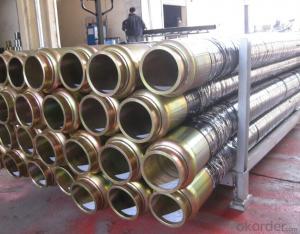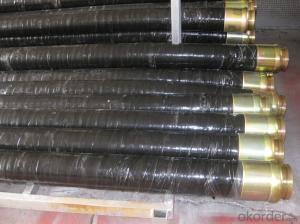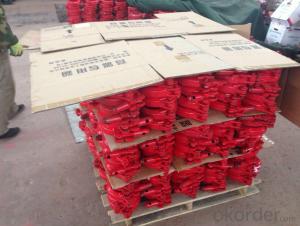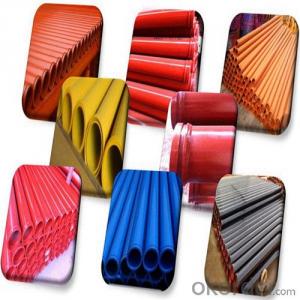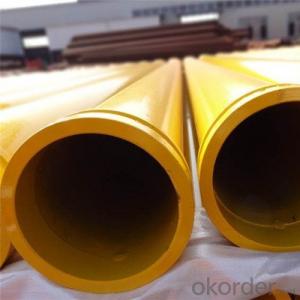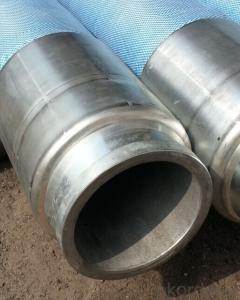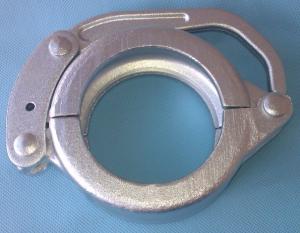5M*DN80 RUBBER END HOSE WITH TWO SIDE COUPLINGS WORKING PRESSURE 85 BAR
- Loading Port:
- Shanghai
- Payment Terms:
- TT OR LC
- Min Order Qty:
- 10 pc
- Supply Capability:
- 5000 pc/month
OKorder Service Pledge
OKorder Financial Service
You Might Also Like
Specifications
Putzmeister concrete pump end rubber hose
1. Size: DN150, DN125, DN100, DN80...
2. Length: 1~9m
Concrete pump end rubber hose PM &Schwing
Name | Specifications | Application | Flange diameter | Remarks |
Rubber hose | DN125*3000 | Concrete pump | 148/DN157mm | |
Rubber hose | DN150*3000 | Concrete pump | 148/DN157mm | |
High pressure | DN125*3000 | Concrete pump | 148/DN157mm | Two layers of steel wire |
High pressure | DN125*3000 | Concrete pump | 148/DN157mm | Four layers of steel wire |
High pressure | DN125*4000 | Concrete pump | 148/DN157mm | |
High pressure | DN150*3000 | Concrete pump | 175mm | |
| DN80*5000 | Mortar pump mini conctete pump | 98mm | |
| DN80*6000 | Mortar pump mini conctete pump | 98mm | |
| DN100*5000 | Mortar pump mini conctete pump | 124mm | |
| DN76*6000 | Fine stone concrete pump mini conctete pump |
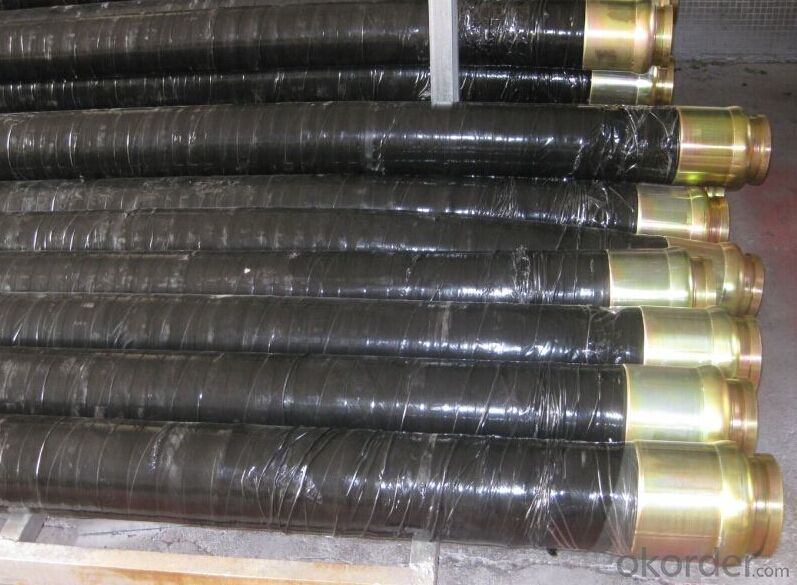
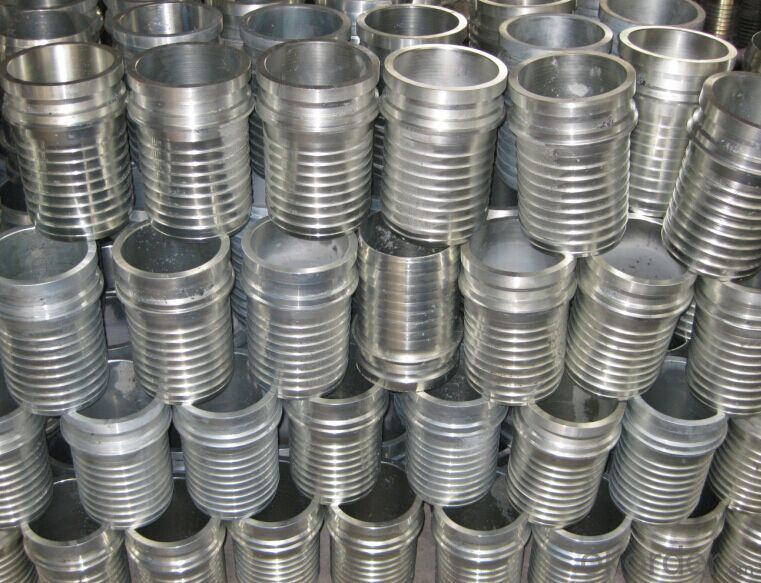
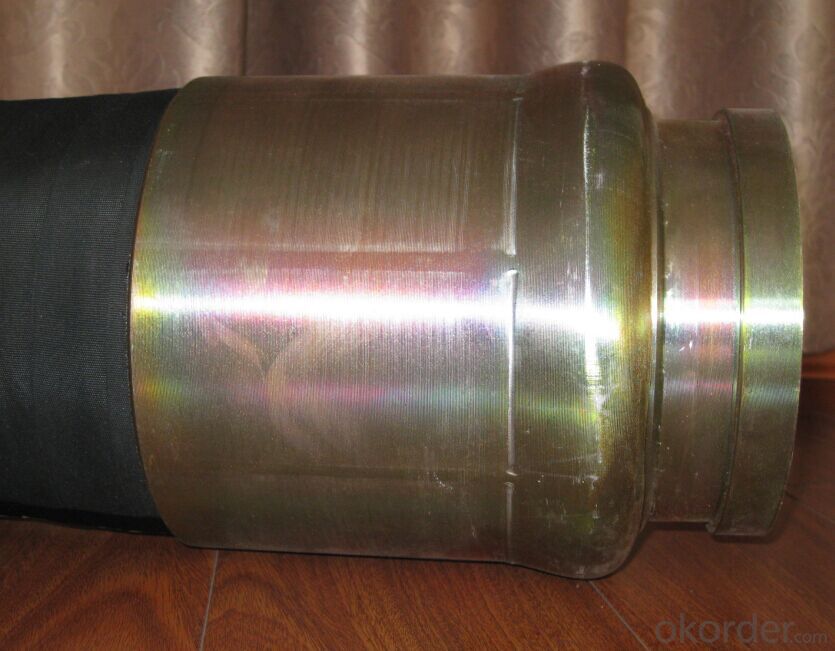

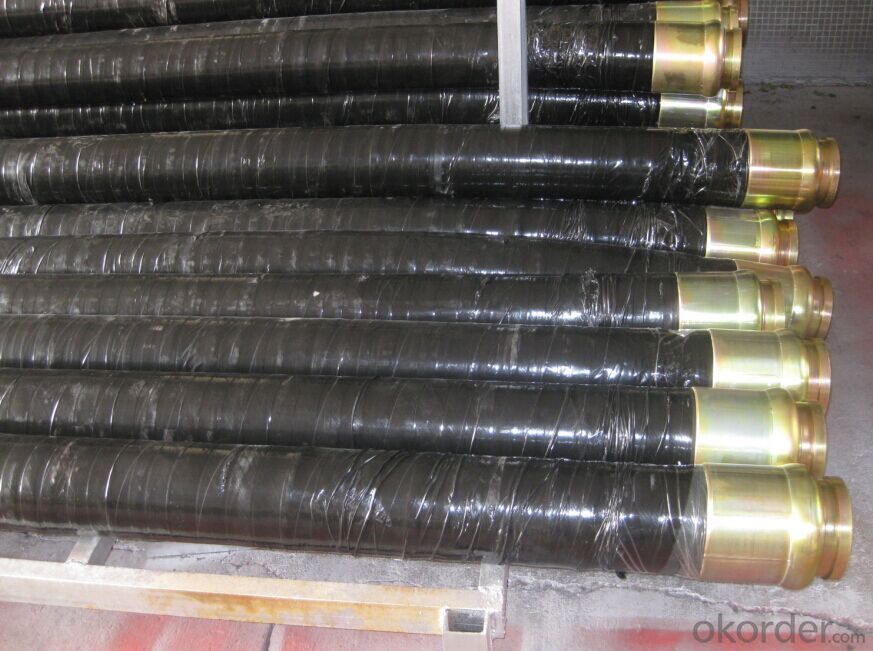
- Q: Can concrete pump spare parts be painted or coated for increased durability?
- Concrete pump spare parts can achieve greater durability by undergoing painting or coating. This protective measure shields them from corrosion, wear, and other types of harm. Applying a layer of paint or coating enhances their resistance against harsh environmental conditions, chemicals, and moisture. Furthermore, certain paints or coatings can provide extra advantages like heat resistance or non-stick properties, further bolstering the spare parts' durability and performance. It is crucial to utilize appropriate paints or coatings that are specifically formulated for the materials and conditions the spare parts will encounter, guaranteeing optimal adhesion and longevity.
- Q: How can a damaged concrete pump hopper affect the pumping process?
- The pumping process can be negatively impacted by a damaged concrete pump hopper in several ways. To begin with, efficiency and productivity can decrease when the hopper is damaged. The hopper's role is to hold and feed the concrete mixture into the pump. Any damage to the hopper can disrupt the continuous flow of concrete, leading to frequent interruptions in the pumping process. This causes delays and reduces the overall output of the pump. Furthermore, the quality of the concrete being pumped can be affected by a damaged hopper. The hopper is designed to ensure proper mixing and consistency of the concrete mixture before it is pumped. If the hopper is damaged, it may not effectively mix the concrete, resulting in inconsistencies in the mixture. This can lead to poor-quality concrete being pumped, compromising the structural integrity and durability of the final product. Additionally, a damaged hopper can pose safety risks for the workers involved in the pumping process. Sharp edges or loose parts on a damaged hopper can cause injury if not addressed properly. Moreover, if the hopper is not functioning correctly, it may cause clogs or blockages in the pump, leading to pressure build-up and potential accidents. Finally, maintenance and repair costs can increase due to a damaged hopper. An imperfect hopper may require frequent repairs or even replacement, which can be time-consuming and expensive. Regular maintenance and inspection of the hopper are crucial to identify any damages early on and prevent them from escalating into more significant issues. In conclusion, a damaged concrete pump hopper has significant implications for the pumping process, including reduced efficiency, compromised concrete quality, safety risks, and increased maintenance costs. Regular inspection, maintenance, and timely repairs are essential to ensure the smooth operation of the pump and the delivery of high-quality concrete.
- Q: How can one determine the correct pressure and flow rating for hydraulic components in concrete pump spare parts?
- To determine the correct pressure and flow rating for hydraulic components in concrete pump spare parts, one must consider the specific requirements and specifications of the concrete pump system. This involves understanding the maximum pressure and flow requirements of the pump, as well as considering factors such as the type and size of the concrete being pumped, the distance and height of the pumping operation, and any additional attachments or accessories being used. It is crucial to consult the manufacturer's guidelines and recommendations, as well as seek advice from hydraulic experts, to ensure the hydraulic components are properly selected for optimal performance and efficiency.
- Q: What are the causes of pipe blockage in concrete pump?
- Therefore, in the JGJ/T10-95 "concrete pumping construction technical regulations," stipulated that the sand through the 0.315mm sieve shall not be less than 15%.
- Q: What is the purpose of a concrete pump cylinder?
- The primary aim of a concrete pump cylinder is to generate the required pressure and force for the transportation and delivery of concrete to a desired location. It serves as a vital element within a concrete pump, facilitating the smooth and productive movement of concrete throughout the pump system. The cylinder operates by utilizing hydraulic pressure to propel the concrete through the pipeline, guaranteeing a continuous and seamless flow. Its significance lies in its contribution to construction projects, enabling accurate and efficient placement of concrete in diverse settings such as buildings, bridges, and other structures. By supplying the necessary power and pressure, the concrete pump cylinder ensures effortless and labor-saving transportation of concrete over long distances, both vertically and horizontally. Ultimately, its purpose revolves around enhancing the efficiency and precision of concrete delivery, thereby saving time and effort in construction endeavors.
- Q: What are the different types of concrete pump hoses?
- There are generally two types of concrete pump hoses: steel-reinforced hoses and fabric-reinforced hoses. Steel-reinforced hoses are stronger and more durable, suitable for high-pressure applications and long-distance pumping. Fabric-reinforced hoses are lightweight and flexible, ideal for smaller projects and shorter pumping distances.
- Q: How can one source reliable suppliers for concrete pump spare parts?
- One can source reliable suppliers for concrete pump spare parts by conducting thorough research, seeking recommendations from industry professionals, checking customer reviews and ratings, and verifying the supplier's credibility and experience in the market. Additionally, attending trade shows and exhibitions related to the construction industry can provide opportunities to connect with reputable suppliers.
- Q: What is the function of a concrete pump hydraulic motor?
- The function of a concrete pump hydraulic motor is to provide the necessary power and motion to operate the pumping mechanism of the concrete pump.
- Q: How does a concrete pump hopper grate prevent clogs?
- A concrete pump hopper grate plays a crucial role in preventing clogs by acting as a filter and allowing only the required size of aggregate or material to pass through. It is designed with small openings or grids that are strategically placed to catch any excess debris, rocks, or large particles that can potentially cause clogs in the pump system. As the concrete mixture is poured into the hopper, the grate acts as a barrier, ensuring that only the properly sized material passes through while obstructing any larger or unwanted debris. This helps maintain the smooth flow of concrete through the pump system, preventing any blockages or jams that can disrupt the construction process. Moreover, the grate is often made of durable materials such as steel or high-density polyethylene, which are resistant to wear and tear. This ensures that it can withstand the high-pressure environment and continuous operation without being damaged or deformed. Regular maintenance and cleaning of the hopper grate are also essential to prevent clogs. By regularly inspecting and removing any accumulated debris or build-up, operators can ensure that the grate remains clear and fully functional, preventing potential clogging issues. In summary, a concrete pump hopper grate prevents clogs by acting as a filter, allowing only the required size of aggregate to pass through while catching any larger particles or debris. Its design and material durability ensure a smooth flow of concrete through the pump system, minimizing the risk of blockages and maintaining the efficiency of construction operations.
- Q: How do I properly maintain and replace concrete delivery pipes in concrete pump spare parts?
- To ensure the concrete pump operates efficiently and safely, it is crucial to properly maintain and replace the concrete delivery pipes in spare parts. Here are some guidelines you can adhere to: 1. Conduct Regular Inspections: Frequently check the concrete delivery pipes for signs of wear, cracks, or damage. Look out for leaks or blockages that may hinder the concrete flow. Identify weak areas that may necessitate replacement. 2. Perform Thorough Cleaning: After each use, clean the concrete delivery pipes meticulously. Use water and a high-pressure hose to eliminate any concrete residue or buildup. This will prevent clogs and maintain a smooth concrete flow. 3. Apply Lubrication: Reduce friction and prevent concrete from adhering to the inner surface of the pipes by applying a suitable lubricant. This practice will elongate the life of the pipes and guarantee a seamless concrete flow. 4. Replace Worn-out Components: Regularly monitor the condition of the delivery pipes and promptly replace any worn-out or damaged parts. Over time, the pipes may corrode or develop cracks, thereby affecting their performance. Replace these components with premium spare parts to achieve optimal outcomes. 5. Handle with Care: Exercise caution when handling the concrete delivery pipes to avoid unnecessary damage. Refrain from dropping or mishandling the pipes during transportation or storage. Shield them from extreme weather conditions and store them in a secure, dry location. 6. Prioritize Training and Safety: Ensure that the personnel operating the concrete pump are well-versed in handling and maintaining the equipment. Educate them on the significance of regular inspections, cleaning, and part replacement. Emphasize safety protocols to prevent accidents and ensure the durability of the concrete delivery pipes. By adhering to these steps, you can effectively maintain and replace the concrete delivery pipes in spare parts for the concrete pump. Consistent maintenance and prompt part replacement will extend the lifespan of the pipes and guarantee a seamless concrete flow during construction projects.
Send your message to us
5M*DN80 RUBBER END HOSE WITH TWO SIDE COUPLINGS WORKING PRESSURE 85 BAR
- Loading Port:
- Shanghai
- Payment Terms:
- TT OR LC
- Min Order Qty:
- 10 pc
- Supply Capability:
- 5000 pc/month
OKorder Service Pledge
OKorder Financial Service
Similar products
Hot products
Hot Searches
Related keywords
